

8 Digital Healthcare UX Trends 2021
source link: https://uxstudioteam.com/ux-blog/healthcare-ux/
Go to the source link to view the article. You can view the picture content, updated content and better typesetting reading experience. If the link is broken, please click the button below to view the snapshot at that time.
8 Digital Healthcare UX Trends 2021
Recently we listed the latest trends in UX and how COVID-19 affected our life. The pandemic also brought changes in digital healthcare trends. In this article, we’d like to point out some of the ways in which UX affects healthcare. In 2021, these technologies will most likely spread, bringing exciting opportunities and important improvements to the healthcare industry.
The health-tech sector is among the fastest-growing in the world today, making the stakes super high. According to a survey from 2019, 88 percent of healthcare providers have invested in, or are evaluating, RPM technologies. Investments in healthcare AI software, hardware, and service market will reach $34 Billion Worldwide by 2025.
We at UX studio have a long history with healthcare UX. When I started here as a designer, guess what happened? One of my first projects focused on healthcare! At first, the responsibility rather perplexed me. I felt the need to take it even more seriously than anything else before. After all, we are talking about a person’s health — their life. My colleagues’ expertise made it a great learning experience, although it was a vast challenge to deal with.
Healthcare UX Challenges
Modern technology in the healthcare system provides patients with better, more comfortable, and safer service. But for this to work, the technology needs to be user-friendly. Healthcare workers need to feel as if they had always used these tools.
But not only doctors take care of our health; we can choose from many digital products helping us perform and live better. User-friendliness, however, holds the key to the success of these apps and gadgets in the long run. In our experience, a healthcare product’s design process must focus not only on what people want but also on what doctors struggle the most with and what treatments and tools the patients need.
Below are some examples of our UX agency’s work in healthcare UX:
We designed InSimu (healthcare education software) and Avizia (telemedicine provider), and some of our currently running projects (pssst, secret!) also relate to healthcare.In the past few years, some relevant changes have taken place in healthcare. Medical industries started to use digital devices more and more, too. Additionally, most healthcare products tend to focus overall on the patient as a customer. Treatments no longer remain boring must-haves; instead, they become services.
Keeping this in mind, let’s check out what UX trends in healthcare we can foresee.
Top 8 healthcare UX challenges tech trends bring
1. Medical wearables
Smart devices have become common in the last years, and they are producing an unimaginable amount of data for researchers and experts. Almost everyone owns a smart bracelet, smartwatch, or at least a fitness monitor app on their phone.
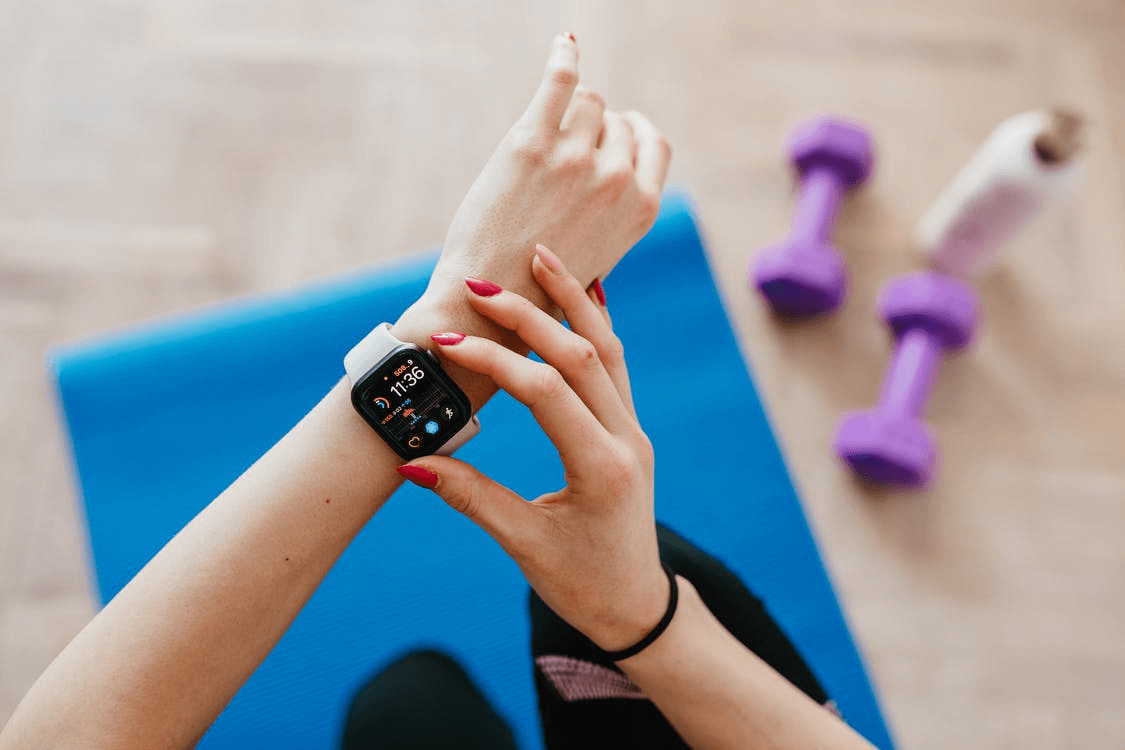 Source: Pexels.com
Source: Pexels.comSelf-monitoring applications made it possible to analyze and change our habits for our well-being. We use colorful data visualization to help us understand how we live; we track our daily activities and steps, analyze our sleeping habits, and check our blood pressure.
Posture trackers analyze our body movements and notify us when we need to stand up and have a short break. It’s getting even more important as people work from home and the space they are living in their everyday lives is getting smaller. Employers also realized this and endeavored to support their remote workers.
Digital stethoscopes are extremely valuable in the current health crisis, so doctors can minimize contact and get data digitized asap.
Latest developments allow medical centers to provide home healthcare kits and monitor patients’ oxygen levels and other symptoms with wearable tools from a distance. This brings us to the next trend.
RPM and Telemedicine go under the Telehealth category. Telecare, also known as teleconsultation, covers remote care, diagnosis, and follow-ups.
2. Remote patient monitoring (RPM)
RPM technologies are beneficial for patients and free up busy medical teams.
Recently clinics applied RPM for recovering COVID-19 patients during an interactive care plan.
This technology can transmit a patient’s vital signs in real-time. Patients can enter symptoms, and wearable tools send information about temperature, blood oxygen level, blood pressure that doctors can monitor and analyze. Dashboards provide guidance and send alerts if changes come up during the disease and help medical staff respond immediately.
3. Telemedicine
One shortcoming with the telemedicine concept is that some doctors or therapists might not have wanted to lose the personal touch. But in 2020, we couldn’t avoid it anymore. Patients and doctors and nurses have interacted virtually more frequently.
By the end of 2020, more than 1 billion doctor-patient visits would have taken place based on Forrester’s research.
Messaging or video-chatting makes everything easier for both parties; patients get answers without putting themselves or others at risk by visiting crowded public spaces, and it also saves time for the medical professionals.
 Source: Pexels.com
Source: Pexels.com4. Consumer-focused design and personalized experiences in healthcare
With information available online at all times, the patient becomes a consumer who has knowledge and interest in the possibilities and circumstances during their medical treatment. With access to their records and treatment history, they can feel involved and better engaged with services.
AbleTo, which helps people suffering from mental problems, sets a good example. With its personalized programs, the patient can control their own treatment. Using understandable language and providing little personalized tips make the whole experience humane.
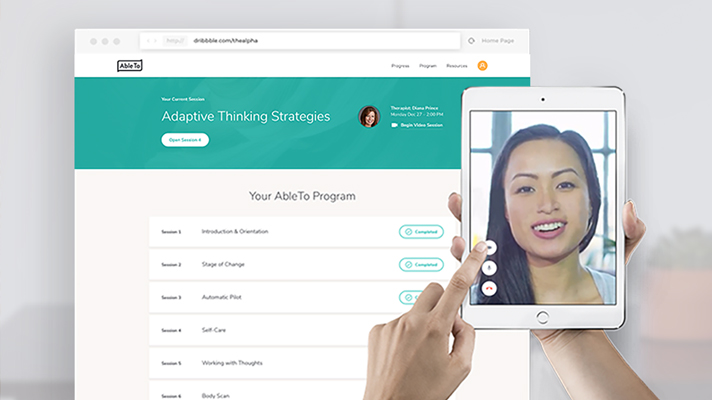 AbleTo offers the opportunity to create your own health program.
AbleTo offers the opportunity to create your own health program.It is the designers’ responsibility to create more personalized journeys. Users become more aware of their overall well-being, and they become industry consumers. They must understand medical expressions, be able to schedule their appointments in a few steps, and check lab results easily. Consequently, patient engagement research gives a huge plus to creating healthcare products.
5. Virtual and Augmented Reality
Virtual Reality (VR) can help to gain experience and simulate situations that we did not have a chance to explore until now. Some healthcare fields already use VR, and this tendency will be growing.
Virtual Reality gains space in more therapeutic situations. The AppliedVR platform specializes in healthcare and lets patients get out of scary medical treatments during a guided relaxation session assisted by a VR tool. Taking them into games or traveling to nice places will draw the patients’ attention away from the reality of unpleasant treatments.
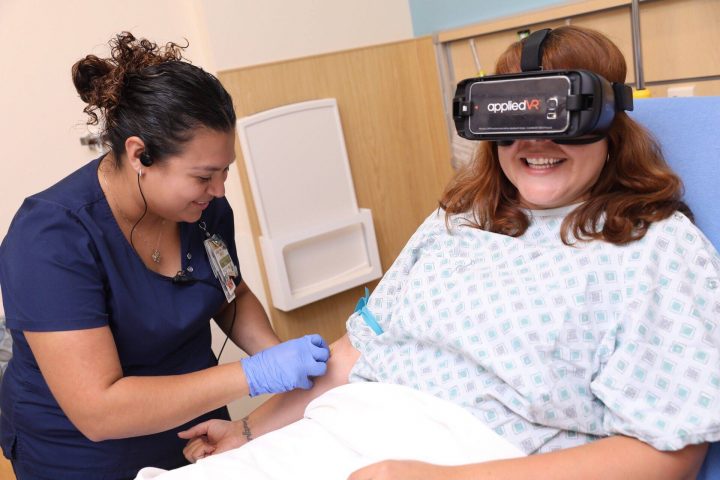 A patient using appliedVR to keep her mind off the pain.
A patient using appliedVR to keep her mind off the pain.Augmented Reality (AR) can show extra information on the digital device in addition to the real world with which it can pioneer surgical planning or diagnostics. Although some developments have already begun, a lot more VR and AR projects will enter into use in healthcare this year.
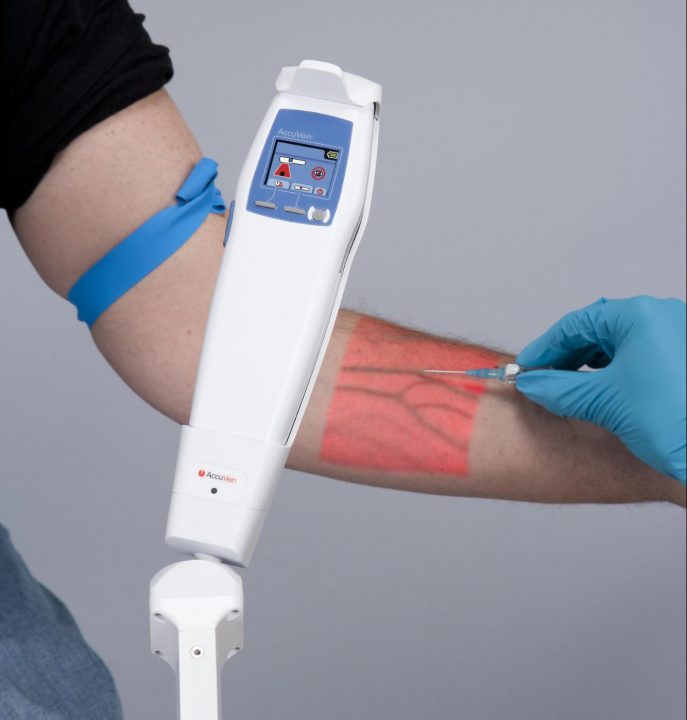 AccuVein uses AR technology to help locate veins for injections.
AccuVein uses AR technology to help locate veins for injections.Moreover, these software technologies could be part of surgical training to approve medical students to practice in real-life environments. With recent VR technologies, doctors can analyze detailed images of COVID-19 patients’ lung scans.
6. AI and Chatbots
Medical teams are overwhelmed, and there is a lack of people when team members fall out due to illness. More help is needed, and AI technologies can take tasks over. Touch-free solutions are essentials in high-risk areas.
Chatbots are one way of help to alleviate the healthcare support system. They need to be made intuitive and provide relevant and well-written responses. Some examples of simple usage of chatbots include appointment booking, medication reminders, or checking on health conditions.
With the advancement of AI, chatbot functionality will be improved to cover more areas in healthcare for both patients and doctors. The right AI will enable chatbots to help patients manage chronic illness, double-check on diagnosis, and provide more personalized and personal responses.
Moreover, with patient-generated data, AI technologies will help collect, and also efficiently analyze the data to provide effective healthcare solutions. According to Tractica, by 2025, AI will help to manage the following areas in the healthcare industry.
- Medical image analysis
- Healthcare VDAs
- Computational drug discovery and drug effectiveness
- Medical treatment recommendation
- Patient data processing
- Medical diagnosis assistance
- Converting paperwork into digital data
- Automated report generation
- Hospital patient management system
- Biomarker discovery
7. Voice User Interfaces
The COVID-19 pandemic has fundamentally changed our perceptions and behaviors in which we use devices. To deploy usage by touching on various devices nowadays carry a risk of being infected or spreading diseases. Hand sanitization and device disinfection help alleviate such potentials. However, the need for frequent use of certain devices such as smartphones, smartwatches, ticket machines makes constant sanitization and disinfection inconvenient or unrealistic.
Here is where voice user interfaces come to play to make devices more efficient and safe to use. Voice user interface means interfaces that facilitate contact-free communications by allowing users to control and command the device systems with speech.
Voice user interface can be very useful during and after the pandemic to ensure safer usage, especially of public devices such as ticket machines and ATMs. In the healthcare sector, voice user interface can be an ideal solution for contactless operation while still integrating with the graphic user interface.
When healthcare workers wear gloves to use touch screens or typing, it is not always as smooth as without gloves. Moreover, the gloves can get dirty. In such realities, contactless operations via a voice user interface with the combination of a graphical user interface are more efficient during the pandemic as well as post the pandemic.
8.Ethical design and digital products for mental health
It is more than clear that social media affects your life and thoughts. You can dig yourself into how dangerous it is, how it keeps us scrolling, clicking, and sharing content all the time. Upcoming trends must deal with this problem.
Doctors and everyday people suffer from anxiety, facing slight or more serious forms of depression, so we should not leave out mentioning applications and digital products for avoiding burnout. Thanks to slow movements, more and more applications help us direct our minds towards mindfulness.
Regular physical exercise reduces anxiety and produces happiness hormones. Having a daily habit sets boundaries and gives the feeling of control. A lot of applications offer free exercise plans with various intensity levels and exercise styles. Usually, they come with well-explained videos to avoid injuries.
Meditation apps come in handy if you just started this journey. Only three to five minutes a day can bring changes into your life in a few weeks. Changes will not only show in your way of thinking, but it affects your physical well-being too.
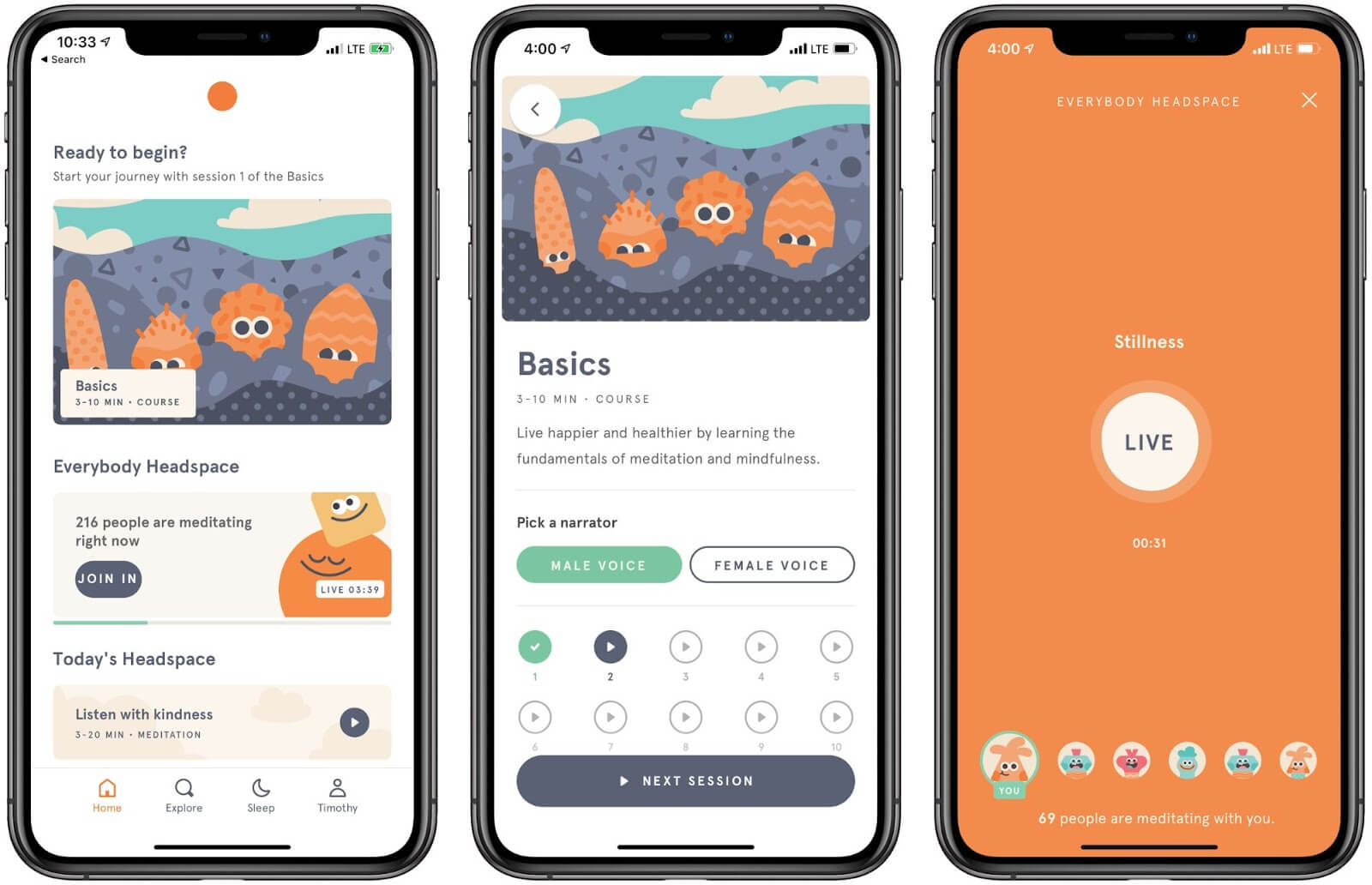
As an example, Headspace is a nicely designed app that is perfect for beginners. A calming voice leads you through guided sessions, and after a few minutes, you feel total zen even in your smallest body parts.
Takeaways
There are quite a few trends that are happening, and their presence and importance will continue to increase in the healthcare industry given the time we live in regarding our physical and mental health states and risks. No matter which of the above-mentioned areas your product or service is focusing on, a good user experience is essential for its success and integrity in improving the well-being of people.
The future of healthcare UX
In this ever-changing whirlwind of medical technology, you want to stay up-to-date, so keep an eye on these trends. Designing medical products brings great responsibility. We must keep people — and their safety — as our focal point. Before aiming for success, first, aim for a valuable service. Create a service that brings value and makes people’s lives better. Designing healthcare UX today isn’t a total joyride. But it’s a ride worth taking.
Searching for the right UX agency?
UX studio has successfully worked with over 250 companies worldwide.
Is there anything we can do for you at this moment? Get in touch with us and let’s discuss your current challenges.
Our experts would be happy to assist with the UX strategy, product and user research, UX/UI design.
Recommend
-
 6
6
-
 7
7
7 Digital Marketing Trends of Focus for 2021 With the chaos of 2020 now behind us, it’s time to look ahead to what we can expect from the next 12 months. 2020 was unpredictable, to say the least. That meant...
-
 6
6
Healthcare 3 Tech Trends Reshaping the Healthcare Industry It might seem ironic that one of the greatest paradigm cha...
-
 2
2
MARKETINGDigital Marketing Trends You Can’t Ignore in 20212020 has been a game-changer for the whole world and many different strategies gained value.
-
 6
6
Europe Animal Healthcare Market Size was US$ 5.75 Billion in 2020. By Products, Animals, Countries, Distribution, Impact of COVID-19, Company Analysis and Forecast 2021-2027.
-
 2
2
Healthcare Technology Trends, Digital Innovations in 2022December 30th 2021 new story4Artificial Int...
-
 2
2
3 data trends that will drive the future of healthcare ...
-
 1
1
The 5 Healthcare AI Trends Technologists Need to Know With the...
-
 5
5
Looking at the 2022 AI in Healthcare Survey The Top Healthcare AI Trends Shaping the Industry Machine Learning
-
 7
7
The Future of Healthcare Software Development: Emerging Trends for 2023 Share Healthcare is constantly evolving, and the latest
About Joyk
Aggregate valuable and interesting links.
Joyk means Joy of geeK